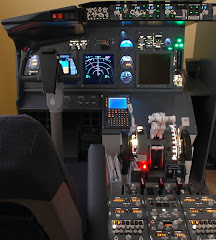In my quest to find a combination of software and hardware that will work reliably, I've discovered a number of truths:
- The flight sim community is a small one but it is very supportive
- Most of the things you are trying to do, others have tried too
- You need to buy more software...
In this post though, I'd like to focus on my fellow anoraks who have helped me along in the process. The first is Lefteris Kalamaras. He heads up
Flight Sim Labs. They are an add on vendor who provided me (well not just me, anyone that wants to buy it really..) with some software that got my Go Flight EFIS unit working, albeit with
PMDG's 747-400X Queen of the Skies
"Whoa!" I hear you cry, "I thought you were building a 737?". True. I've got a problem with the PMDG crew, I'll save that for another post.
Right now though we're talking about Lefteris. Only had a couple of email exchanges with him but I found him to be a real gentleman. My day job is in the software industry so I know all about not committing the features of your product by certain release dates. Lefteris though assured me that "soon" means within my natural life expectancy, unlike those creeps over in PMDG whose definition of "coming soon" is so vague you must wonder if they mean within this millennium (another post, another post...Grrrrr!). Lefteris was also gracious in his response to my forum posting on how to get started, which you can read in my post earlier today, if you're interested...
Next up is someone who probably has no idea how much time, effort and frustration he saved me. The man is
Vidar Fagerjord. How did he help? Well, the big name in flight sim add ons for serious sim builders is
Project Magenta. Their software is the standard that all others are measured by. Problem is, it's very expensive. So before I went down that path, I wanted to make sure that PIC737 would work with it. The insight that Vidar provided that I'd failed to figure out for myself
you don't need an add on aircraft for Project Magenta to work! It will quite happily work with the default 737 in FSX and augments it's crappy systems with a full featured, networkable solution.
Now we'll save the run down on Project Magenta for another post. For now though I want to thank Vidar for his help. He put me on the right path and made clear that you get what you pay for with Project Magenta (they owe him a commission). By the way, Vidar is very active in a number of flight sim forums - I'm sure you'll run into him along the way.
There are some flight sim builders out there who are an inspiration. I mentioned Robert Vandenberghe earlier today. The real artists though are people like
Alain Tremblay, this
chap from Belgium (sorry, can't find his name),
Nic D'Alessandro and
Ian Sissons (BTW Ian, any chance you can give me those measurements I asked for?). I steal liberally from their websites, as you will see with my build out...
Next on deck is retired United Captain and chairman of the Airline Pilot's Historical Society,
Mr. Nick Louis. We'll talk more about my dealings with Nick later. In the meanwhile you need to know that he:
- Provides decommissioned real aircraft parts for sim enthusiasts to incorporate in their cockpits
- In his own words donates "generously, and regularly to children's hospitals, homeless shelters that specialize in families with children and other important entities of that type….Your support through purchases or donations is required, and I am not ashamed to ask for your continued loyalty. The gloves are off. Sick kids need our help...they'll get it."
My last tip of the hat goes to someone I have had no contact with, other than to buy his superb software - Mr.
Pete Dowson. The flight sim world owes a debt of gratitude to Pete, for producing FSUIPC, software that makes the integration of all of the disparate parts of hardware and software come together. We'll be talking more about Pete's handiwork in later posts.
Next up - what the new cockpit will look like...











